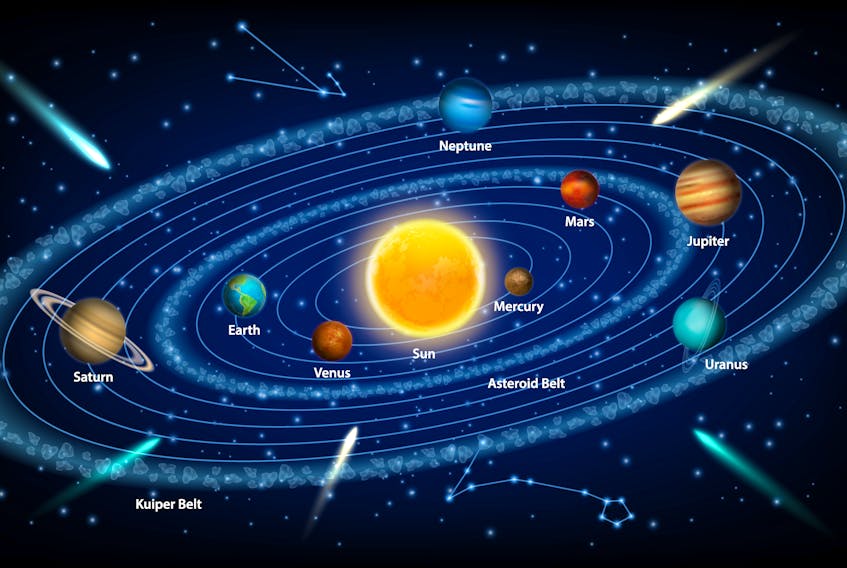The distances between planets in our solar system are so big, they are measured in terms of astronomical units (one AU equals approximately 150,000,000 kilometres - the average distance between the Earth and the sun).
But what about the size of the planets relative to each other and the sun?
First, we'll need some base reference points. Earth has an equatorial diameter of 12,756 kms (0.009 times the sun). By contrast, our sun, the centre of our solar system, is a whopping 1.39 million kms in diameter (109 times that of Earth). Approximately 1,300,000 Earths could fit inside the sun.
Our solar system's innermost planet, Mercury - named for the winged messenger of the gods in Roman mythology - is a mere 4,880 kms in diameter (0.38 times Earth, 0.004 times the sun). The next planet out is Venus, named after the Roman goddess of love, with a diameter of 12,104 kms (0.95 times Earth, 0.009 times the sun).
Sliding past Earth - the only planet not named for a Greek or Roman deity - we come to Mars, the Roman god of war, with a diameter of 6,794 kms (0.53 times Earth, 0.005 times the sun). Next is mighty Jupiter, the supreme god of Roman mythology, with a gigantic diameter of 142,984 kms (11.2 times Earth, 0.1 times the sun). Beyond Jupiter lies the ringed-planet Saturn, Roman god of wealth and agriculture, with a diameter of 120,536 kms (9.4 times Earth, 0.09 times the sun).
Saturn is followed by Uranus, named after the ancient Greek god of the sky, with a diameter of 51,118 kms (4.0 times Earth, 0.04 times the sun). The last planet out (at least according to the 2006 ruling of the International Astronomical Union (IAU)) is Neptune, Roman god of the sea, whose diameter is 49,528 kms (3.9 times Earth, 0.04 times the sun).
Being old-school (like most of you, I was taught that it was our "ninth planet"), I'll include Pluto, Roman god of the underworld. This diminutive planet, demoted from planet status to that of a "dwarf planet" by the IAU in 2006, has a diameter of only 2,300 kms (0.18 times Earth, 0.002 times the sun).
To give you a sense of scale, if we shrank the sun down to the size of a 44-centimetre beach ball, the planets would appear as follows - Mercury (0.15 cms in diameter, at 22 metres from the beach ball); Venus (0.38 cms diameter, at 34 m); Earth (0.40 cms diameter, at 48 m); Mars (0.21 cms diameter, at 80 m); Jupiter (4.52 cms diameter, at 260 m); Saturn (3.68 cms diameter, at 480 m); Uranus (1.6 cms diameter, at 950 m), Neptune (1.56 cms diameter, at 1.43 kms), and Pluto (0.07 cms diameter, at 2.3 kms). Have a sense yet of how incredibly amazing our solar system is, and how small the planets actually are compared to the sun?
This week's sky
Mercury, approaching inferior conjunction with the sun, is not observable this coming week. On June 23, Mercury is at aphelion (farthest from the sun). Jupiter (magnitude -2.7) rises in the southeast shortly before midnight, reaches its highest point in the southern sky around 3 a.m., then disappears from view at a height of 16 degrees in the southwest sky by 5 a.m.
Saturn (magnitude 0.3) rises a few minutes after midnight, reaching a height of 23 degrees above the southern horizon around 3:20 a.m., then fading from sight above the southern horizon around 4:40 a.m.
Mars (magnitude -0.3) makes an appearance in the eastern sky around 1:30 a.m., reaching 30 degrees above the south-east horizon as it fades from view about 4:45 a.m.
Our "morning star", Venus (magnitude -4.2) is visible in the pre-dawn sky, rising around 4 a.m., reaching eight degrees above the eastern horizon before fading from view by 5 a.m.
Look for the "Summer Triangle" in the eastern evening sky just as dusk turns to darkness from now through July. This asterism (picture within a picture) consists of three stars from three different constellations - Vega (Lyra - the harp), Deneb (Cygnus - the swan), and Altair (Aquila - the eagle).
Until next week, clear skies.
Events:
June 23 - Mercury at aphelion (farthest from the sun)
June 28 - First quarter moon
Glenn K. Roberts lives in Stratford, P.E.I., and has been an avid amateur astronomer since he was a small child. He welcomes comments from readers, and anyone who would like to do so is encouraged to email him at [email protected].









